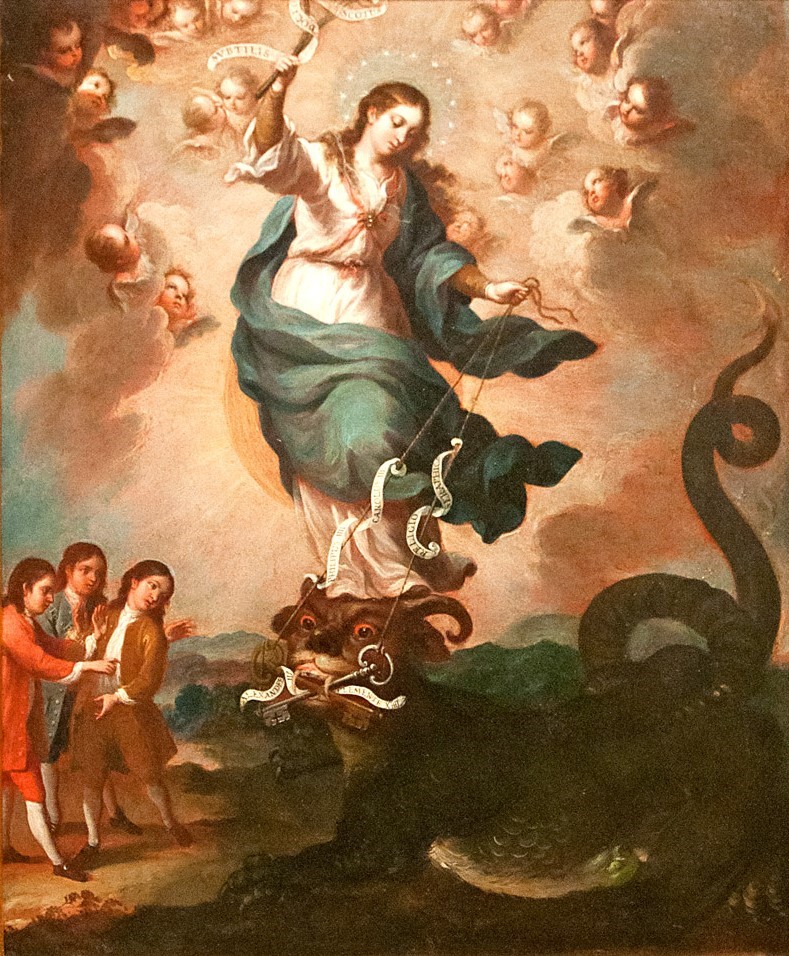The Immaculate Conception of the Blessed Virgin Mary,
Patronal Feast Day of the United States of America,
8 December 2021
Gen 3:9-15, 20; Eph 1:3-6, 11-12; Lk 1:26-38.
Theme: Mother of God, teach us to believe,
to hope and to love with you.
Guide us on our way to the Kingdom of God.
Mother of the Church[1] in a Post Christian Culture[2]
The Patronal Feast Day of the United States of America awakens the sense of the faithful and the sense of the Church universal to the doctrine that Mary was conceived, as all of us, by the beautiful love of our parents with the singular privilege of being preserved from original sin. The baptized are liberated from original sin. Bl. John Duns Scotus (1265-1308) argued to be preserved is a superior grace to being liberated from original sin. His thought builds upon the fact to which every other consideration must be related as to its motive and end. That is the absolute predestination of Christ and Mary Immaculate.[3] The predestination of all else is in view of this. The development is Newmanian.
Duns Scotus identified and explained the key to a genuine Christo-centrism: the absolute primacy, firstness, or predestination of the Word Incarnate to be Savior of the World. The subtle and Marian Franciscan argued in favor of the Immaculate Virgin to be the Savior’s Mother and set the stage to be Mother of the Church as the plan from eternity to take place jointly with the Savior.
The great merit of Duns Scotus is to have identified and explained why the Word Incarnate was predestined to be the Savior of the World, not because of the sin of Adam but because of the love of God from eternity. That simple truth is to be shouted from the rooftops. Mary Immaculate is predestined jointly with Him to be His Mother and the Mother of the Church.[4]
Recognition of Mary as Mother of the Church is fitting during a perceived freefall of truth accompanying the post-Christian culture. Christian faithful recognize the doubleness of modernity with its gifts and crises. Some cheer, others weep, and still others mix reactions. Love and devotion to the Mother of the Church brings comfort and reassures the unfailing presence of infinite Love. The development of the term post-Christian culture is along three lines: external factors; the length of time of response of Church leaders; and truth about complicity, intended or not.
Post-Christian culture identifies external factors bearing on truth, certainty, certitude, and the direction of contemporary culture. Second, the secular invasion and temporization of Church authorities in dealing with the secular invasion intensifies the ambiguity of external factors. The faithful are not deaf to the reproaches directed at authorities in the Church nor fail to see the justice in some reproaches. Third, by inviting in the secular, ideologies and ideas in openness and cultural encounter, if lacking competence to regulate Christianly, amounts to complicity in creating a post-Christian culture.[5]
The feast of the Immaculate Conception of the Mother of God defines concretely Woman who is such because she is Immaculate Conception, so holy as to be able to be Virginal-Mother of God (WK 1318).[6] St. Maximilian Kolbe’s Scotistic perspective treats feminine in metaphysical terms before empirical terms. Duns Scotus is defining woman concretely by the Woman who is the Immaculate Conception. Male and female are used empirically as subordinate to the terms metaphysically. He differentiates and identifies that for which and to which all the rest of creation is related.
The relation is a mystery (not a problem, nor myth, certainly not a fable) that enables the faithful to come to understand person in the Trinity and person in the economy of salvation (Mary and all of us). Irenaeus calls Mary the “new Eve.”[7] Medieval Christian writers call Mary “new Woman.” Contrast with the old Eve and blame for the fall. Eve was deceived. Adam knew better, was weak, used to comforts, failed to take a stand, was complicit and is more responsible in this original sin.[8]
Even if it appears generous, the dignity of persons, the dignity of women, and acting justly seems to be growing worldwide. Upright human conduct is hope in action. Suffering, shocks, cries for vengeance, remind that the power of sin against the dignity of persons continues. Contemporary secularism, which is sturdily empirical, operates within the dual gift of modernity. A Franciscan emphasis and interpretation employ a Scotistic metaphysical approach first as well as empirical approach.
The headline making term “gender” often confuses. A Scotistic perspective on gender employs the metaphysical approach, without denying inclusion of empirical psychological reasons. E.G., a Scotistic perspective builds with metaphysical principles to resolve questions that accompany gender as: 1.) creation, Creator and gender; 2.) Mary, Trinity and gender; and 3.) Divine Maternity, Trinity and gender. Many layers require critical engagement. Amplification of the Scotistic perspective is my goal.
Kolbe, a Scotist, is a theologian and philosopher who considers the personality of the Church as bride of Christ to be the extension of the Virgin Mary. Think of the maximum glory of Christ or the salvation of the Church as realized in the triumph of the Immaculate Heart, the Mother of the Church. Ponder how this paraphrases the Scotistic thesis with which I began. The primacy of Christ shows the divine plan to make possible the final glory of Christ which is the love of Mary Immaculate and the motive of our salvation. Kolbe notes that this truth (WK 1305) points in the direction that everything in the Church, including the priesthood and hierarchy, is nuanced in a feminine way.
Kolbe’s pneumatology rests on the mode of the Incarnation and the mode of salvation as primarily Marian, without ever making them effeminate! For many different reasons, critics on the right and left claim Kolbe gives radical support to the feminine personality of the Holy Spirit and for the Immaculate Conception as a kind of second hypostatic union. If critics read the texts of Kolbe (now available in English as WK), they would be hard pressed to validate such claims.
Kolbe summarizes: “In the union of the Holy Spirit with Her, not only does love conjoin two beings but the first of these is all the Love of the Most Holy Trinity while the second is all the love of creation, and so in that union…is conjoined…all of Uncreated Love with all of created love: the vertex of love”. “The Immaculate…, the apex of perfection in creation, the Mother of God, the sublimest of creatures” (WK 1318; 1325) who is Mother of the Church.
In Celebration of My Golden Jubilee Year of Priesthood, Fr. Edward J. Ondrako, O.F.M.Conv.
eondrako@alumni.nd.edu
____________________________________________
[1]Mother of the Church is the title Pope St. Paul VI gave to Mary in 1964. Pope Francis approved the feast be celebrated by the Universal Church on the day after Pentecost. Paul VI longed for all Christians to turn to Mary as Mother of the Church. Recall St. John Henry Newman’s seven notes of true development of doctrine (1845).
[2] Using the diagnostic, post-Christian culture, might upset the faithful who love Mary with their innermost heart. Doubt not! Mary remains in our midst as our Mother, the Mother of Hope. See Pope Benedict XVI, Spe Salvi 50.
[3] Duns Scotus does not treat the predestination of Mary in his published works, but his approach to predestination to glory before any consideration of sin and redemption was taken up mainly by his disciples. Developments follow in logical order so that his theory of the joint predestination of Christ and Mary is now part of the ordinary Magisterium. See Vatican II, Lumen Gentium, ch. 8, n. 61. Peter D. Fehlner attests to this true development.
[4] The lynchpin of joint predestination in LG 61 is uno eodemque decreto, by one and the same decree.
[5] Post-Christian culture is a term I align with “hope” in Pope Benedict XVI, Spe Salvi (2007).
[6] See St. Maximilian M. Kolbe, Writings of Kolbe (Lugano: Nerbini, 2016), Eng trans. is WK 1318; Ital. is SK.
[7] Irenaeus, Adversus Haereses, (c. 180), 3:21 and 22. 4. The Second Eve undoes the “knot that Eve tied.”
[8] J. C. Cavadini, Visioning Augustine (Oxford: Wiley-Blackwell, 2019), 211-238. Adam should have sacrificed!
Fr. Edward J. Ondrako, OFM Conventual
Research Fellow Pontifical Faculty of St. Bonaventure, Rome
Visiting Scholar, McGrath Institute for Church Life
University of Notre Dame
November 8, 2021

